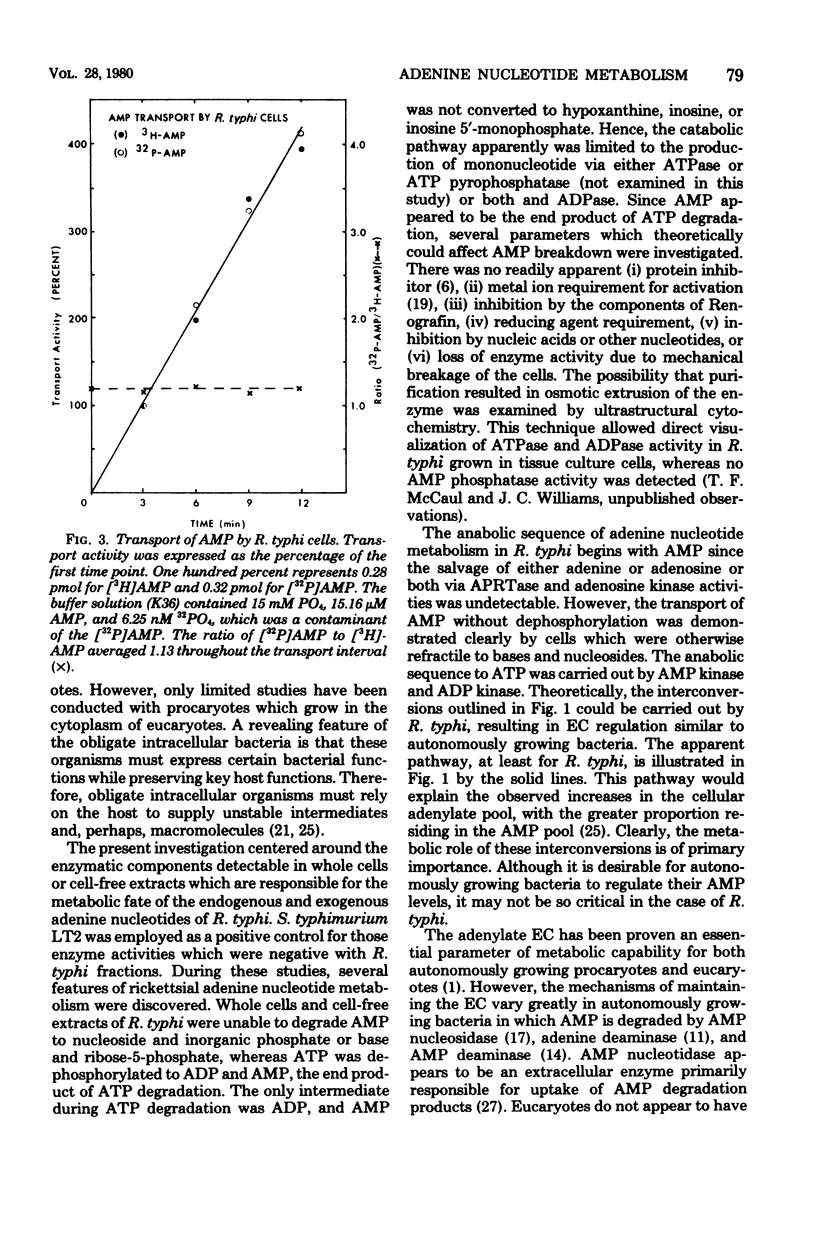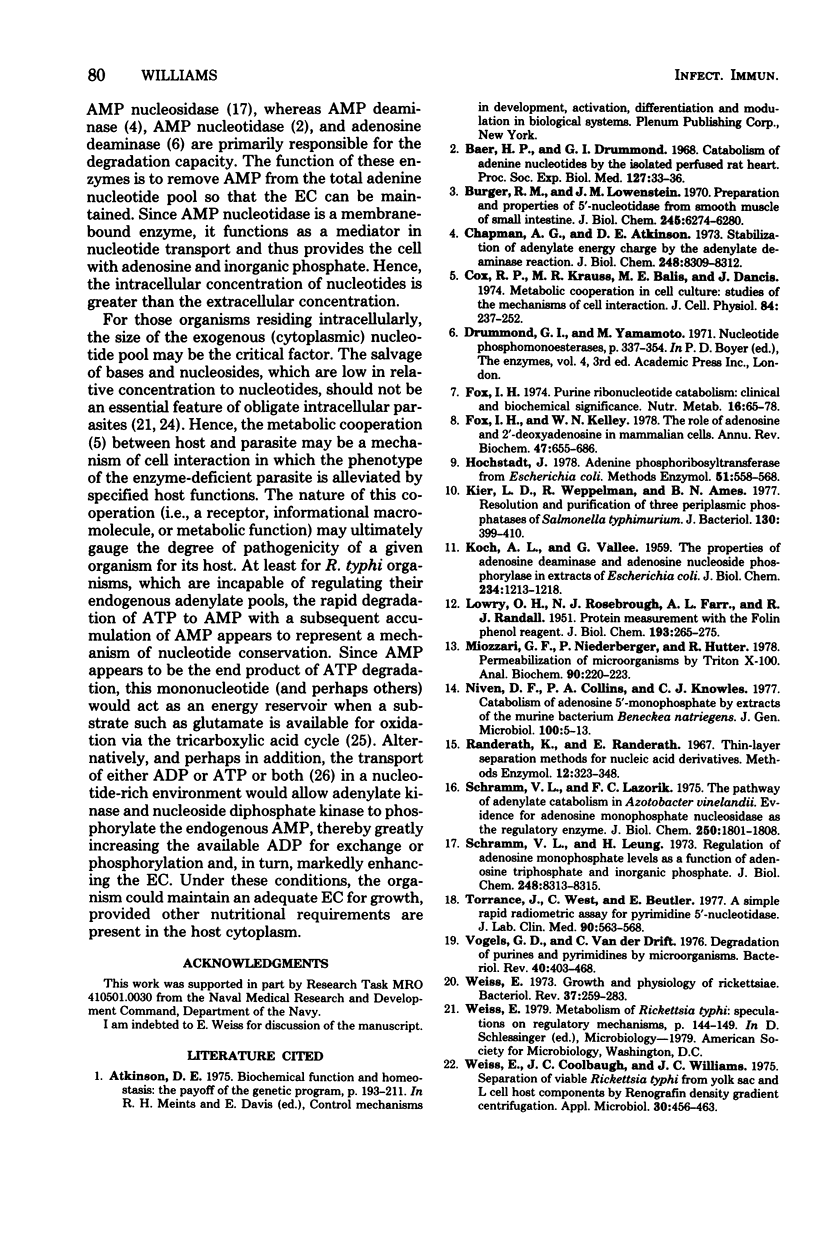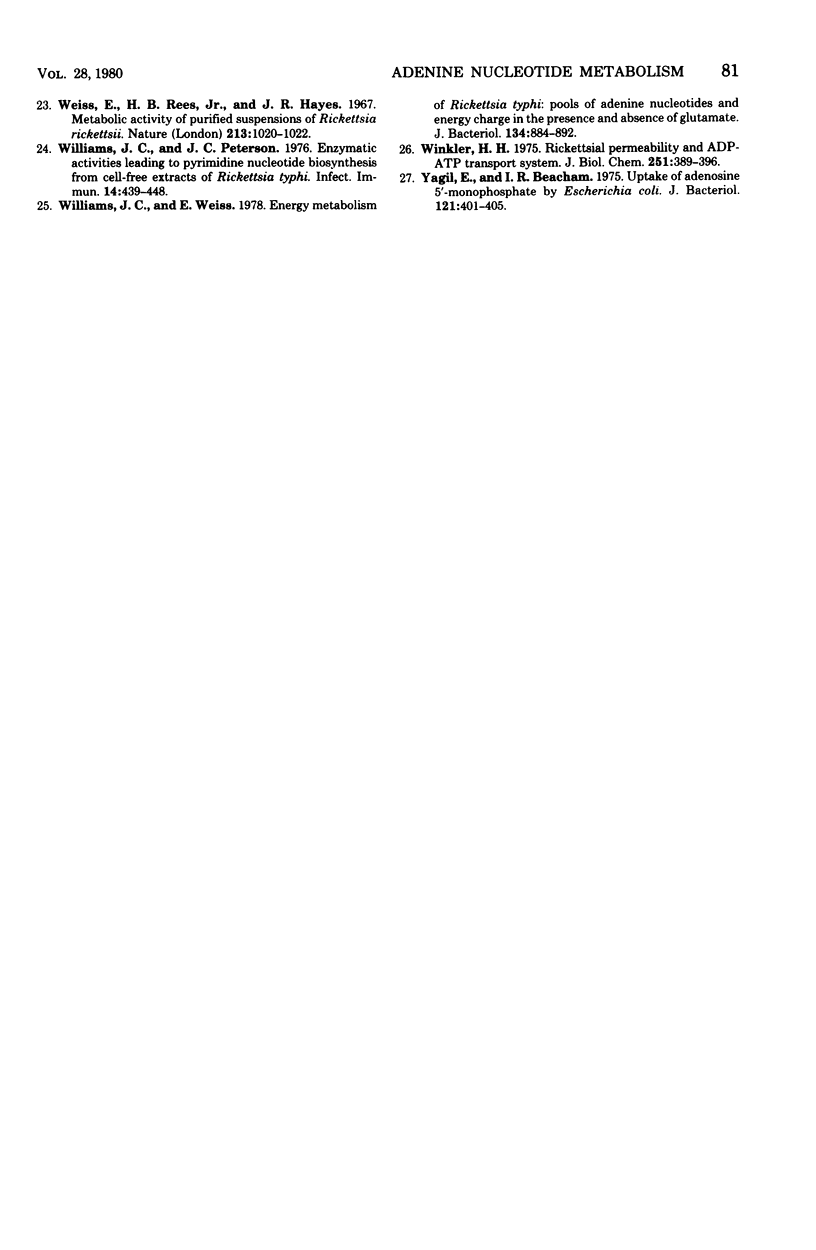Abstract
Adenosine 5′-triphosphate (ATP) was catabolized by whole cells and cell-free extracts of Rickettsia typhi to adenosine 5′-diphosphate (ADP) and then to adenosine 5′-monophosphate (AMP), the end product of ATP catabolism under the experimental conditions used. The only intermediate of the pathway from ATP to AMP which was identified by thin-layer chromatography and quantitated by the 14C content was ADP, whereas products such as adenine, adenosine, hypoxanthine, inosine, and inosine 5′-monophosphate were not detected. The enzymes which could be theoretically responsible for the catabolism or the anabolism of AMP were not detected by standard assay procedures. Most importantly, 5′-nucleotidase or nonspecific phosphatase and AMP nucleosidase activities were undetectable under a variety of experimental conditions. Although these two enzymes remove AMP from the adenylate pool in other cells, they are apparently nonfunctional in R. typhi. The biosynthesis of ATP was initiated by adenylate kinase because no adenine phosphoribosyltransferase or adenosine kinase could be detected. Furthermore, AMP was transported intact without prior dephosphorylation. These observations suggest that for R. typhi the in vivo activity of adenine nucleotide interconversion was limited to the nucleotides, with AMP being the end product of ATP catabolism, and that the salvage of purine bases and nucleosides was not an essential feature of purine metabolism. These results elucidate the findings of a previous study which showed that in the absence of glutamate as a source of energy, the adenylate energy charge of resting cells of R. typhi is drastically lowered by the high proportion of AMP.
Full text
PDF







Selected References
These references are in PubMed. This may not be the complete list of references from this article.
- Atkinson D. E. Biochemical function and homeostasis: the payoff of the genetic program. Adv Exp Med Biol. 1975;62:193–211. doi: 10.1007/978-1-4684-3255-8_11. [DOI] [PubMed] [Google Scholar]
- Baer H. P., Drummond G. I. Catabolism of adenine nucleotides by the isolated perfused rat heart. Proc Soc Exp Biol Med. 1968 Jan;127(1):33–36. doi: 10.3181/00379727-127-32614. [DOI] [PubMed] [Google Scholar]
- Burger R. M., Lowenstein J. M. Preparation and properties of 5'-nucleotidase from smooth muscle of small intestine. J Biol Chem. 1970 Dec 10;245(23):6274–6280. [PubMed] [Google Scholar]
- Chapman A. G., Atkinson D. E. Stabilization of adenylate energy charge by the adenylate deaminase reaction. J Biol Chem. 1973 Dec 10;248(23):8309–8312. [PubMed] [Google Scholar]
- Cox R. P., Krauss M. R., Balis M. E., Dancis J. Metabolic cooperation in cell culture: studies of the mechanisms of cell interaction. J Cell Physiol. 1974 Oct;84(2):237–252. doi: 10.1002/jcp.1040840210. [DOI] [PubMed] [Google Scholar]
- Fox I. H., Kelley W. N. The role of adenosine and 2'-deoxyadenosine in mammalian cells. Annu Rev Biochem. 1978;47:655–686. doi: 10.1146/annurev.bi.47.070178.003255. [DOI] [PubMed] [Google Scholar]
- Fox I. H. Purine ribonucleotide catabolism: clinical and biochemical significance. Review. Nutr Metab. 1974;16(2):65–78. doi: 10.1159/000175474. [DOI] [PubMed] [Google Scholar]
- Goodwin C. S., Tyrrell D. A., Head B., Rees R. J. Inhibition of haemaggregation by lepromin and other mycobacterial substances. Nature. 1967 Dec 9;216(5119):1019–1020. doi: 10.1038/2161019a0. [DOI] [PubMed] [Google Scholar]
- Hochstadt J. Adenine phosphoribosyltransferase from Escherichia coli. Methods Enzymol. 1978;51:558–567. doi: 10.1016/s0076-6879(78)51078-1. [DOI] [PubMed] [Google Scholar]
- KOCH A. L., VALLEE G. The properties of adenosine deaminase and adenosine nucleoside phosphorylase in extracts of Escherichia coli. J Biol Chem. 1959 May;234(5):1213–1218. [PubMed] [Google Scholar]
- Kier L. D., Weppelman R., Ames B. N. Resolution and purification of three periplasmic phosphatases of Salmonella typhimurium. J Bacteriol. 1977 Apr;130(1):399–410. doi: 10.1128/jb.130.1.399-410.1977. [DOI] [PMC free article] [PubMed] [Google Scholar]
- LOWRY O. H., ROSEBROUGH N. J., FARR A. L., RANDALL R. J. Protein measurement with the Folin phenol reagent. J Biol Chem. 1951 Nov;193(1):265–275. [PubMed] [Google Scholar]
- Miozzari G. F., Niederberger P., Hütter R. Permeabilization of microorganisms by Triton X-100. Anal Biochem. 1978 Oct 1;90(1):220–233. doi: 10.1016/0003-2697(78)90026-x. [DOI] [PubMed] [Google Scholar]
- Schramm V. L., Lazorik F. C. The pathway of adenylate catabolism in Azotobacter vinelandii. Evidence for adenosine monophosphate nucleosidase as the regulatory enzyme. J Biol Chem. 1975 Mar 10;250(5):1801–1808. [PubMed] [Google Scholar]
- Schramm V. L., Leung H. Regulation of adenosine monophosphate levels as a function of adenosine triphosphate and inorganic phosphate. A proposed metabolic role for adenosine monophosphate nucleosidase from Azotobacter vinelandii. J Biol Chem. 1973 Dec 10;248(23):8313–8315. [PubMed] [Google Scholar]
- Torrance J., West C., Beutler E. A simple rapid radiometric assay for pyrimidine-5'-nucleotidase. J Lab Clin Med. 1977 Sep;90(3):563–568. [PubMed] [Google Scholar]
- Vogels G. D., Van der Drift C. Degradation of purines and pyrimidines by microorganisms. Bacteriol Rev. 1976 Jun;40(2):403–468. doi: 10.1128/br.40.2.403-468.1976. [DOI] [PMC free article] [PubMed] [Google Scholar]
- Weiss E., Coolbaugh J. C., Williams J. C. Separation of viable Rickettsia typhi from yolk sac and L cell host components by renografin density gradient centrifugation. Appl Microbiol. 1975 Sep;30(3):456–463. doi: 10.1128/am.30.3.456-463.1975. [DOI] [PMC free article] [PubMed] [Google Scholar]
- Weiss E. Growth and physiology of rickettsiae. Bacteriol Rev. 1973 Sep;37(3):259–283. doi: 10.1128/br.37.3.259-283.1973. [DOI] [PMC free article] [PubMed] [Google Scholar]
- Williams J. C., Peterson J. C. Enzymatic activities leading to pyrimidine nucleotide biosynthesis from cell-free extracts of Rickettsia typhi. Infect Immun. 1976 Aug;14(2):439–448. doi: 10.1128/iai.14.2.439-448.1976. [DOI] [PMC free article] [PubMed] [Google Scholar]
- Williams J. C., Weiss E. Energy metabolism of Rickettsia typhi: pools of adenine nucleotides and energy charge in the presence and absence of glutamate. J Bacteriol. 1978 Jun;134(3):884–892. doi: 10.1128/jb.134.3.884-892.1978. [DOI] [PMC free article] [PubMed] [Google Scholar]
- Winkler H. H. Rickettsial permeability. An ADP-ATP transport system. J Biol Chem. 1976 Jan 25;251(2):389–396. [PubMed] [Google Scholar]
- Yagil E., Beacham I. R. Uptake of adenosine 5'-monophosphate by Escherichia coli. J Bacteriol. 1975 Feb;121(2):401–405. doi: 10.1128/jb.121.2.401-405.1975. [DOI] [PMC free article] [PubMed] [Google Scholar]


